MITSUBISHI ECLIPSE CROSS 2019 Owner's Manual (in English)
Manufacturer: MITSUBISHI, Model Year: 2019, Model line: ECLIPSE CROSS, Model: MITSUBISHI ECLIPSE CROSS 2019Pages: 423, PDF Size: 75.41 MB
Page 171 of 423
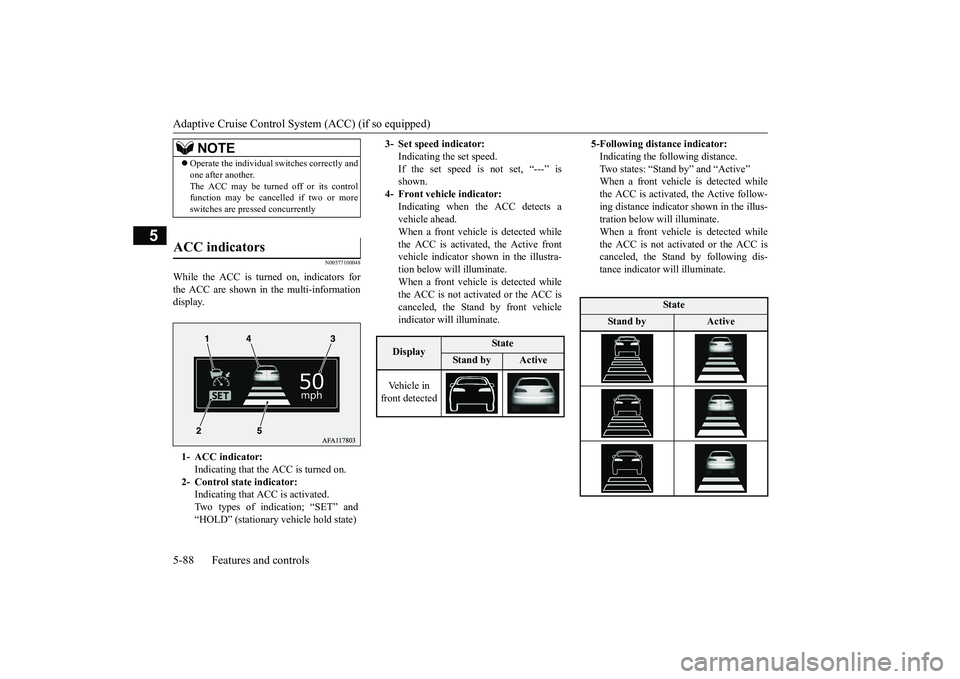
Adaptive Cruise Control System (ACC) (if so equipped) 5-88 Features and controls
5
N00577100048
While the ACC is turned on, indicators for the ACC are shown in the multi-information display.
NOTE
Operate the individual switches correctly and one after another. The ACC may be turned off or its control function may be cancelled if two or more switches are pressed concurrently
ACC indicators
1- ACC indicator:
Indicating that the ACC is turned on.
2- Control state indicator:
Indicating that ACC is activated. Two types of indication; “SET” and“HOLD” (stationary vehicle hold state)
3- Set speed indicator:
Indicating the set speed. If the set speed is not set, “---” is shown.
4- Front vehicle indicator:
Indicating when the ACC detects a vehicle ahead. When a front vehicle is detected whilethe ACC is activated, the Active front vehicle indicator shown in the illustra- tion below will illuminate.When a front vehicle is detected whilethe ACC is not activated or the ACC is canceled, the Stand by front vehicle indicator will illuminate.Display
State
Stand by
Active
Vehicle in front detected
5-Following distance indicator: Indicating the following distance.Two states: “Stand by” and “Active” When a front vehicle is detected while the ACC is activated, the Active follow-ing distance indicator shown in the illus- tration below will illuminate. When a front vehicle is detected whilethe ACC is not activated or the ACC is canceled, the Stand by following dis- tance indicator will illuminate.
State
Stand by
Active
BK0266800US.bo
ok 88 ページ 2018年6月27日 水曜日 午後5時6分
Page 172 of 423
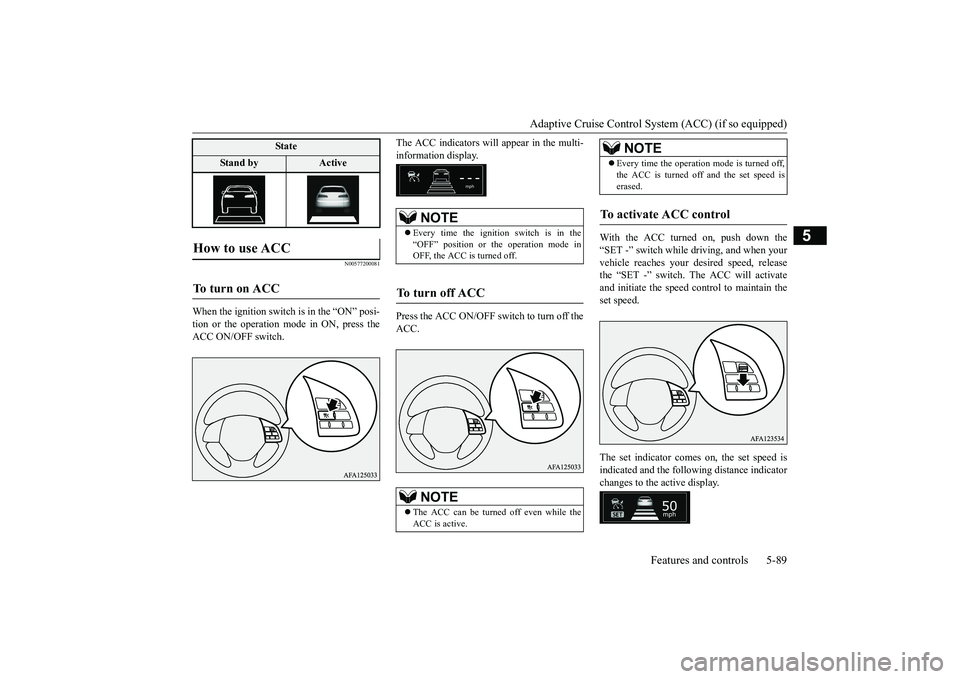
Adaptive Cruise Control System (ACC) (if so equipped)
Features and controls 5-89
5
N00577200081
When the ignition switch is in the “ON” posi- tion or the operation mode in ON, press theACC ON/OFF switch.
The ACC indicators will appear in the multi- information display. Press the ACC ON/OFF switch to turn off the ACC.
With the ACC turned on, push down the “SET -” switch while driving, and when your vehicle reaches your desired speed, releasethe “SET -” switch. The ACC will activateand initiate the speed control to maintain the set speed. The set indicator comes on, the set speed is indicated and the following distance indicatorchanges to the active display.
How to use ACC
To turn on ACC
State
Stand by
Active
NOTE
Every time the ignition switch is in the “OFF” position or the operation mode inOFF, the ACC is turned off.
To turn off ACC
NOTE
The ACC can be turned off even while the ACC is active.
Every time the operation mode is turned off, the ACC is turned off and the set speed is erased.
To activate ACC control
NOTE
BK0266800US.bo
ok 89 ページ 2018年6月27日 水曜日 午後5時6分
Page 173 of 423
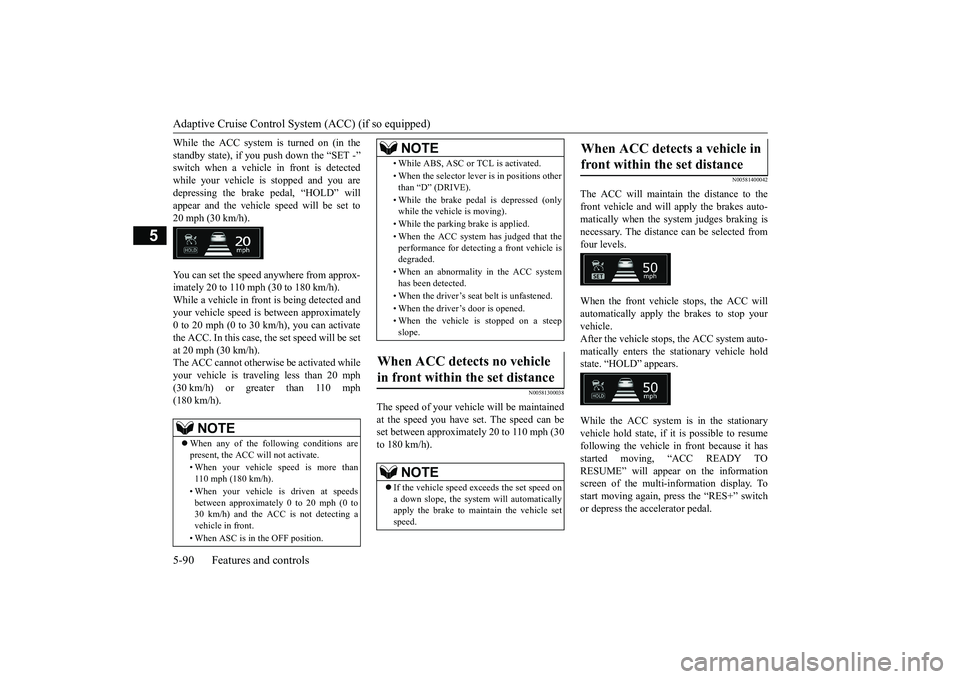
Adaptive Cruise Control System (ACC) (if so equipped) 5-90 Features and controls
5
While the ACC system is turned on (in the standby state), if you push down the “SET -” switch when a vehicle in front is detected while your vehicle is stopped and you aredepressing the brake pedal, “HOLD” will appear and the vehicle speed will be set to 20 mph (30 km/h). You can set the speed anywhere from approx- imately 20 to 110 mph (30 to 180 km/h). While a vehicle in front is being detected and your vehicle speed is between approximately0 to 20 mph (0 to 30 km/h), you can activatethe ACC. In this case, the set speed will be set at 20 mph (30 km/h). The ACC cannot otherwise be activated whileyour vehicle is traveling less than 20 mph (30 km/h) or greater than 110 mph (180 km/h).
N00581300038
The speed of your vehicle will be maintainedat the speed you have set. The speed can be set between approximately 20 to 110 mph (30 to 180 km/h).
N00581400042
The ACC will maintain the distance to thefront vehicle and will apply the brakes auto- matically when the system judges braking is necessary. The distance can be selected fromfour levels. When the front vehicle stops, the ACC will automatically apply the brakes to stop yourvehicle. After the vehicle stops, the ACC system auto- matically enters the stationary vehicle holdstate. “HOLD” appears. While the ACC system is in the stationary vehicle hold state, if it is possible to resume following the vehicle in front because it has started moving, “ACC READY TORESUME” will appear on the information screen of the multi-information display. To start moving again, press the “RES+” switchor depress the accelerator pedal.
NOTE
When any of the following conditions are present, the ACC will not activate. • When your vehicle speed is more than 110 mph (180 km/h). • When your vehicle is driven at speeds between approximately 0 to 20 mph (0 to30 km/h) and the ACC is not detecting a vehicle in front. • When ASC is in the OFF position.
• While ABS, ASC or TCL is activated. • When the selector lever is in positions other than “D” (DRIVE). • While the brake pedal is depressed (only while the vehicle is moving). • While the parking brake is applied. • When the ACC system has judged that the performance for detecting a front vehicle is degraded. • When an abnormality in the ACC system has been detected. • When the driver’s seat belt is unfastened. • When the driver’s door is opened.• When the vehicle is stopped on a steep slope.
When ACC detects no vehicle in front within the set distance
NOTE
If the vehicle speed exceeds the set speed on a down slope, the system will automaticallyapply the brake to maintain the vehicle set speed.NOTE
When ACC detects a vehicle in front within the set distance
BK0266800US.bo
ok 90 ページ 2018年6月27日 水曜日 午後5時6分
Page 174 of 423
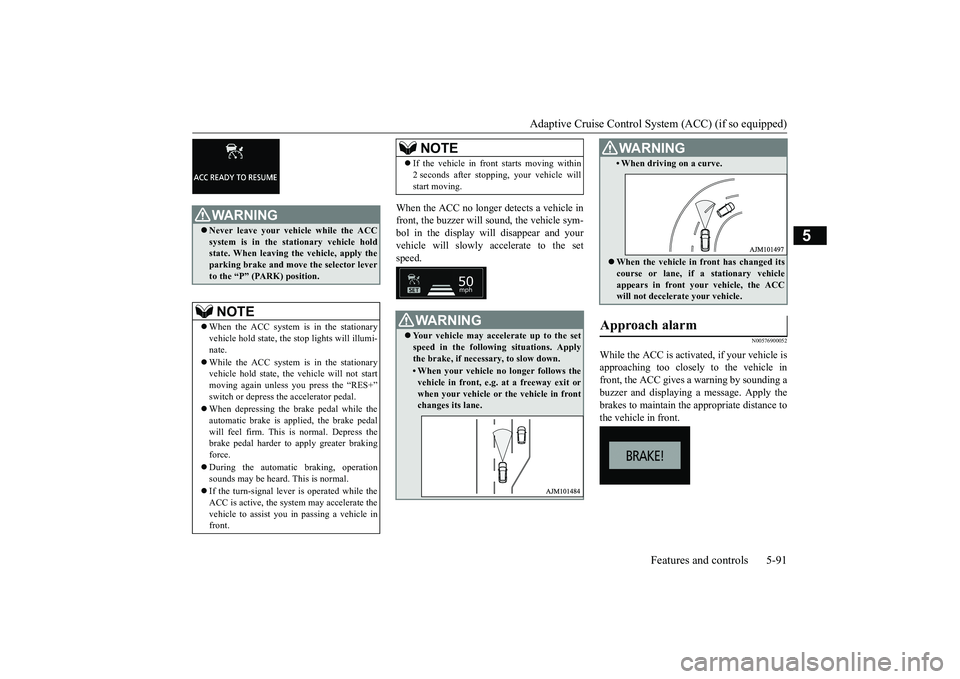
Adaptive Cruise Control System (ACC) (if so equipped)
Features and controls 5-91
5
When the ACC no longer detects a vehicle in front, the buzzer will sound, the vehicle sym- bol in the display will disappear and your vehicle will slowly accelerate to the setspeed.
N00576900052
While the ACC is activat
ed, if your vehicle is
approaching too closely to the vehicle infront, the ACC gives a warning by sounding a buzzer and displaying a message. Apply the brakes to maintain the appropriate distance tothe vehicle in front.
WA R N I N G Never leave your vehicle while the ACC system is in the stationary vehicle hold state. When leaving the vehicle, apply the parking brake and move the selector leverto the “P” (PARK) position.NOTE
When the ACC system is in the stationary vehicle hold state, the stop lights will illumi-nate. While the ACC system is in the stationary vehicle hold state, the vehicle will not start moving again unless you press the “RES+” switch or depress the accelerator pedal. When depressing the brake pedal while the automatic brake is applied, the brake pedalwill feel firm. This is normal. Depress the brake pedal harder to apply greater braking force. During the automatic braking, operation sounds may be heard. This is normal. If the turn-signal lever is operated while the ACC is active, the system may accelerate the vehicle to assist you in passing a vehicle in front.
If the vehicle in front starts moving within 2 seconds after stopping, your vehicle will start moving.WA R N I N G Your vehicle may accelerate up to the set speed in the following situations. Apply the brake, if necessary, to slow down.• When your vehicle no longer follows thevehicle in front, e.g. at a freeway exit or when your vehicle or the vehicle in frontchanges its lane.NOTE
• When driving on a curve. When the vehicle in front has changed its course or lane, if a stationary vehicle appears in front your vehicle, the ACC will not decelerate your vehicle.
Approach alarm
WA R N I N G
BK0266800US.bo
ok 91 ページ 2018年6月27日 水曜日 午後5時6分
Page 175 of 423
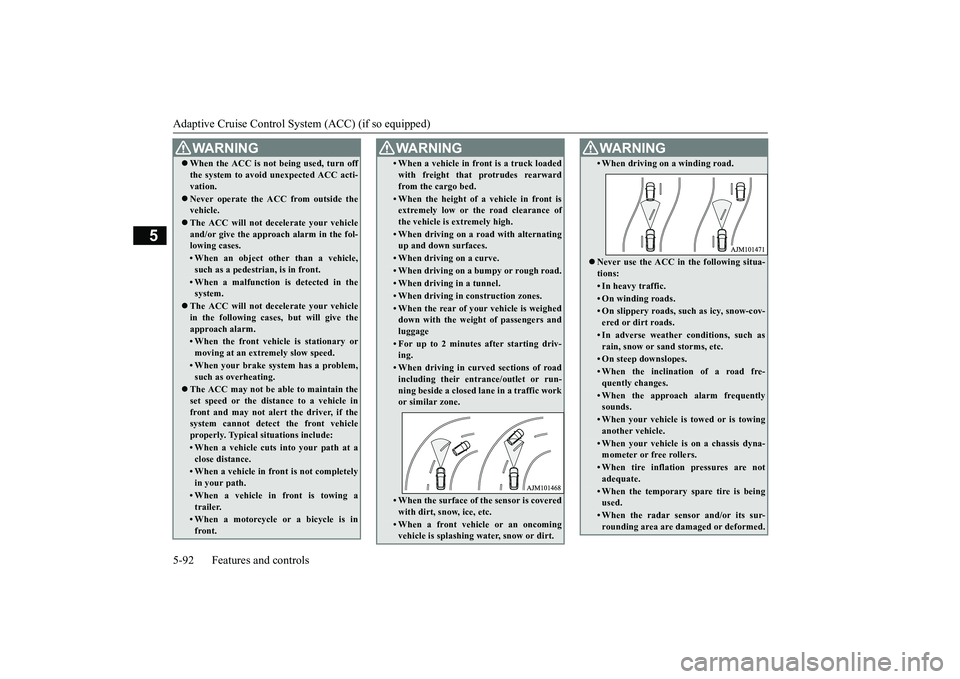
Adaptive Cruise Control System (ACC) (if so equipped) 5-92 Features and controls
5
WA R N I N G When the ACC is not being used, turn off the system to avoid unexpected ACC acti- vation. Never operate the ACC from outside the vehicle. The ACC will not decelerate your vehicle and/or give the approach alarm in the fol- lowing cases.• When an object other than a vehicle,such as a pedestrian, is in front. • When a malfunction is detected in thesystem.
The ACC will not decelerate your vehicle in the following cases, but will give the approach alarm.• When the front vehicle is stationary ormoving at an extremely slow speed.• When your brake system has a problem,such as overheating.
The ACC may not be able to maintain the set speed or the distance to a vehicle infront and may not alert the driver, if the system cannot detect the front vehicle properly. Typical situations include: • When a vehicle cuts into your path at aclose distance.• When a vehicle in front is not completelyin your path.• When a vehicle in front is towing atrailer.• When a motorcycle or a bicycle is infront.
• When a vehicle in front is a truck loaded with freight that protrudes rearward from the cargo bed.• When the height of a vehicle in front isextremely low or the road clearance of the vehicle is extremely high.• When driving on a road with alternatingup and down surfaces.• When driving on a curve.• When driving on a bumpy or rough road.• When driving in a tunnel.• When driving in construction zones.• When the rear of your vehicle is weighed down with the weight of passengers and luggage• For up to 2 minutes after starting driv-ing.• When driving in curved sections of roadincluding their entrance/outlet or run- ning beside a closed lane in a traffic workor similar zone.• When the surface of the sensor is coveredwith dirt, snow, ice, etc.• When a front vehicle or an oncomingvehicle is splashing water, snow or dirt. WA R N I N G
• When driving on a winding road. Never use the ACC in the following situa- tions:• In heavy traffic.• On winding roads.• On slippery roads, such as icy, snow-cov- ered or dirt roads.• In adverse weather conditions, such asrain, snow or sand storms, etc.• On steep downslopes.• When the inclination of a road fre- quently changes.• When the approach alarm frequentlysounds.• When your vehicle is towed or is towinganother vehicle.• When your vehicle is on a chassis dyna-mometer or free rollers.• When tire inflation pressures are notadequate.• When the temporary spare tire is beingused.• When the radar sensor and/or its sur-rounding area are damaged or deformed.WA R N I N G
BK0266800US.bo
ok 92 ページ 2018年6月27日 水曜日 午後5時6分
Page 176 of 423
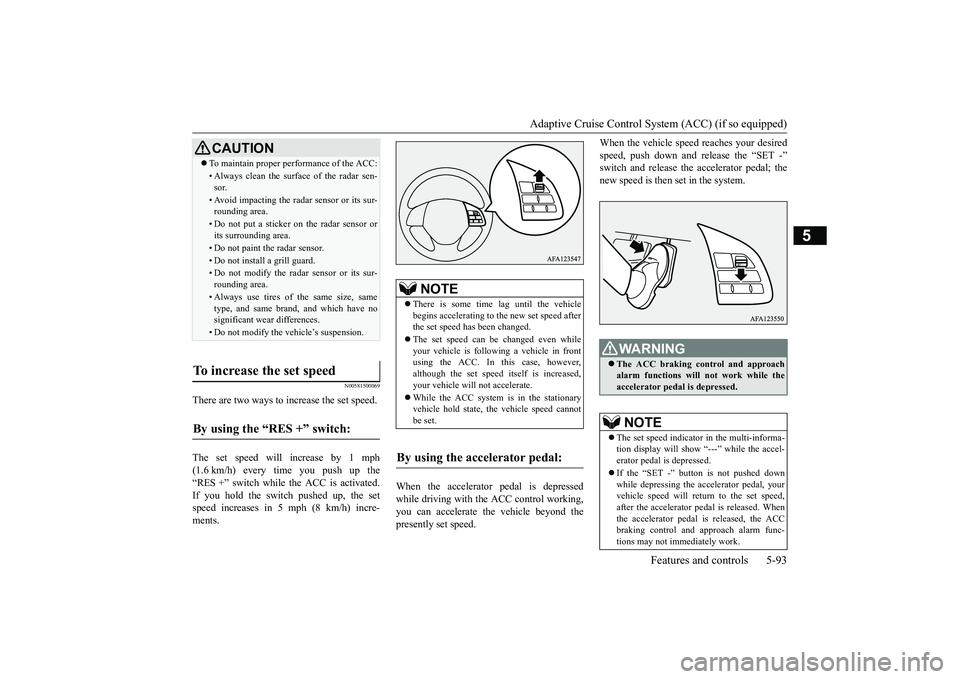
Adaptive Cruise Control System (ACC) (if so equipped)
Features and controls 5-93
5
N00581500069
There are two ways to increase the set speed. The set speed will increase by 1 mph (1.6 km/h) every time you push up the“RES +” switch while the ACC is activated. If you hold the switch pushed up, the set speed increases in 5 mph (8 km/h) incre-ments.
When the accelerator pedal is depressed while driving with the ACC control working,you can accelerate the vehicle beyond the presently set speed.
When the vehicle speed reaches your desired speed, push down and release the “SET -” switch and release the accelerator pedal; the new speed is then set in the system.
CAUTION To maintain proper performance of the ACC:• Always clean the surface of the radar sen- sor.• Avoid impacting the radar sensor or its sur-rounding area.• Do not put a sticker on the radar sensor orits surrounding area.• Do not paint the radar sensor.• Do not install a grill guard.• Do not modify the radar sensor or its sur- rounding area.• Always use tires of the same size, sametype, and same brand, and which have nosignificant wear differences.• Do not modify the vehicle’s suspension.
To increase the set speed
By using the “RES +” switch:
NOTE
There is some time lag until the vehicle begins accelerating to the new set speed after the set speed has been changed. The set speed can be changed even while your vehicle is following a vehicle in frontusing the ACC. In this case, however, although the set speed itself is increased, your vehicle will not accelerate. While the ACC system is in the stationary vehicle hold state, the vehicle speed cannotbe set.
By using the accelerator pedal:
WA R N I N G The ACC braking control and approach alarm functions will not work while the accelerator pedal is depressed.NOTE
The set speed indicator in the multi-informa- tion display will show “---” while the accel- erator pedal is depressed. If the “SET -” button is not pushed down while depressing the accelerator pedal, yourvehicle speed will return to the set speed, after the accelerator pedal is released. When the accelerator pedal is released, the ACCbraking control and approach alarm func- tions may not immediately work.
BK0266800US.bo
ok 93 ページ 2018年6月27日 水曜日 午後5時6分
Page 177 of 423
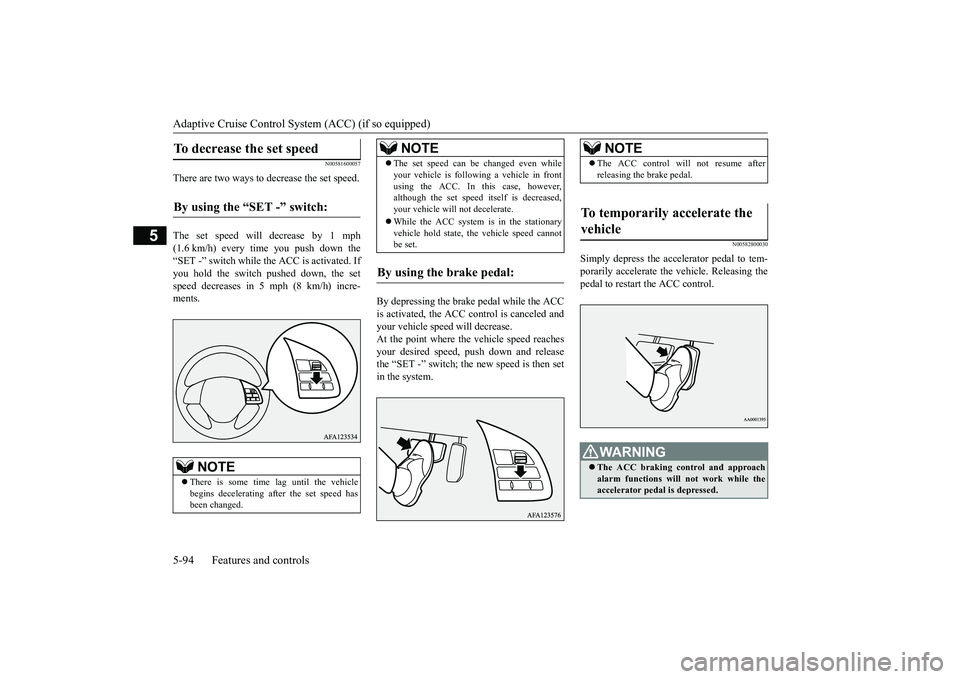
Adaptive Cruise Control System (ACC) (if so equipped) 5-94 Features and controls
5
N00581600057
There are two ways to decrease the set speed. The set speed will decrease by 1 mph (1.6 km/h) every time you push down the “SET -” switch while the ACC is activated. Ifyou hold the switch pushed down, the setspeed decreases in 5 mph (8 km/h) incre- ments.
By depressing the brake pedal while the ACC is activated, the ACC control is canceled and your vehicle speed will decrease.At the point where the vehicle speed reaches your desired speed, push down and release the “SET -” switch; the new speed is then setin the system.
N00582800030
Simply depress the accelerator pedal to tem-porarily accelerate the vehicle. Releasing thepedal to restart the ACC control.
To decrease the set speed
By using the “SET -” switch:
NOTE
There is some time lag until the vehicle begins decelerating after the set speed has been changed.
The set speed can be changed even while your vehicle is following a vehicle in front using the ACC. In this case, however, although the set speed itself is decreased, your vehicle will not decelerate. While the ACC system is in the stationary vehicle hold state, the vehicle speed cannotbe set.
By using the brake pedal:
NOTE
NOTE
The ACC control will not resume after releasing the brake pedal.
To temporarily accelerate the vehicle
WA R N I N G The ACC braking control and approach alarm functions will not work while the accelerator pedal is depressed.
BK0266800US.bo
ok 94 ページ 2018年6月27日 水曜日 午後5時6分
Page 178 of 423
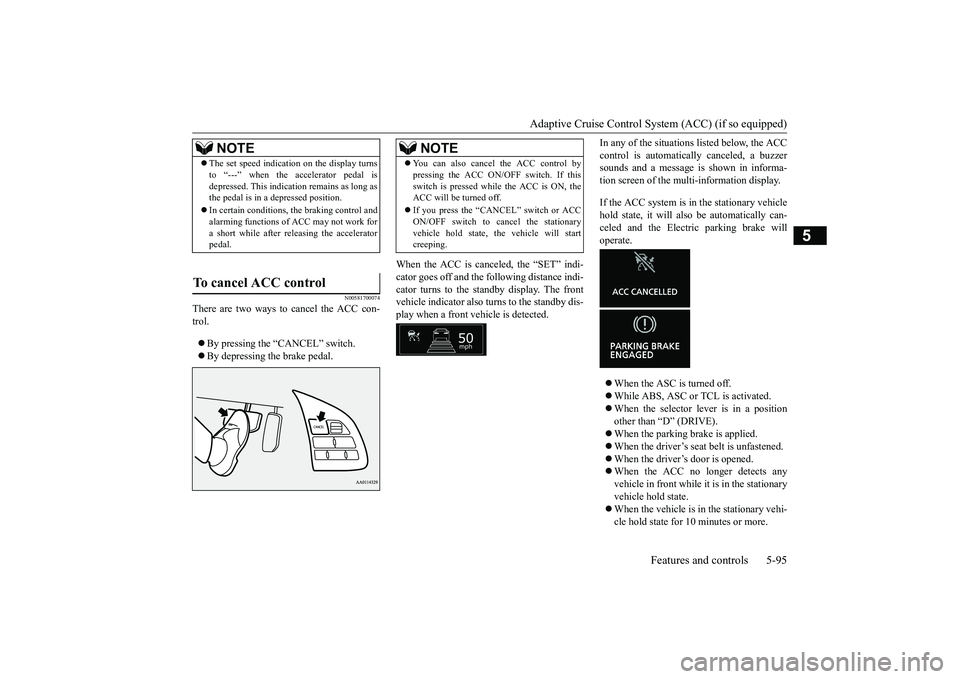
Adaptive Cruise Control System (ACC) (if so equipped)
Features and controls 5-95
5
N00581700074
There are two ways to cancel the ACC con- trol. By pressing the “CANCEL” switch. By depressing the brake pedal.
When the ACC is canceled, the “SET” indi- cator goes off and the following distance indi-cator turns to the standby display. The front vehicle indicator also turns to the standby dis- play when a front vehicle is detected.
In any of the situations listed below, the ACC control is automatically canceled, a buzzer sounds and a message is shown in informa- tion screen of the multi-information display. If the ACC system is in the stationary vehicle hold state, it will also be automatically can- celed and the Electric parking brake will operate. When the ASC is turned off. While ABS, ASC or TCL is activated. When the selector lever is in a position other than “D” (DRIVE). When the parking brake is applied. When the driver’s seat belt is unfastened. When the driver’s door is opened. When the ACC no longer detects any vehicle in front while it is in the stationaryvehicle hold state. When the vehicle is in the stationary vehi- cle hold state for 10 minutes or more.
NOTE
The set speed indication on the display turns to “---” when the accelerator pedal is depressed. This indication remains as long as the pedal is in a depressed position. In certain conditions, the braking control and alarming functions of ACC may not work for a short while after releasing the acceleratorpedal.
To cancel ACC control
NOTE
You can also cancel the ACC control by pressing the ACC ON/OFF switch. If this switch is pressed while
the ACC is ON, the
ACC will be turned off. If you press the “CANCEL” switch or ACC ON/OFF switch to cancel the stationary vehicle hold state, the vehicle will startcreeping.
BK0266800US.bo
ok 95 ページ 2018年6月27日 水曜日 午後5時6分
Page 179 of 423
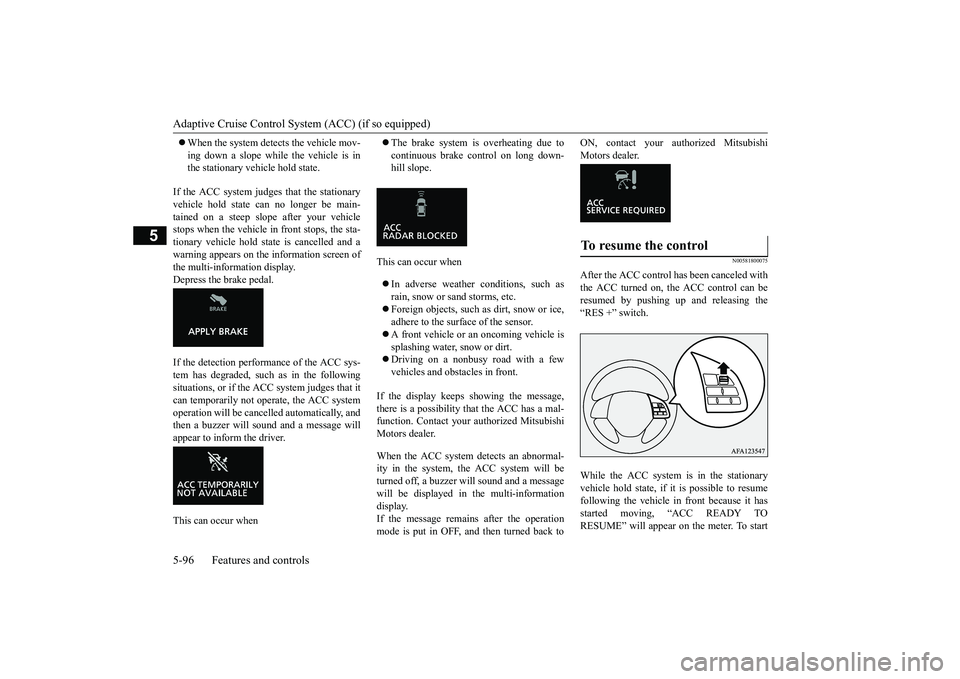
Adaptive Cruise Control System (ACC) (if so equipped) 5-96 Features and controls
5
When the system detects the vehicle mov- ing down a slope while the vehicle is in the stationary vehicle hold state.
If the ACC system judges that the stationary vehicle hold state can no longer be main-tained on a steep slope after your vehicle stops when the vehicle in front stops, the sta- tionary vehicle hold state is cancelled and awarning appears on the information screen of the multi-information display. Depress the brake pedal. If the detection performance of the ACC sys- tem has degraded, such as in the following situations, or if the ACC system judges that it can temporarily not operate, the ACC systemoperation will be cancelled automatically, and then a buzzer will sound and a message will appear to inform the driver. This can occur when
The brake system is overheating due to continuous brake control on long down- hill slope.
This can occur when In adverse weather conditions, such as rain, snow or sand storms, etc. Foreign objects, such as dirt, snow or ice, adhere to the surface of the sensor. A front vehicle or an oncoming vehicle is splashing water, snow or dirt. Driving on a nonbusy road with a few vehicles and obstacles in front.
If the display keeps showing the message, there is a possibility that the ACC has a mal- function. Contact your authorized Mitsubishi Motors dealer. When the ACC system detects an abnormal- ity in the system, the ACC system will beturned off, a buzzer will sound and a message will be displayed in the multi-information display.If the message remains after the operation mode is put in OFF, and then turned back to
ON, contact your authorized Mitsubishi Motors dealer.
N00581800075
After the ACC control has been canceled withthe ACC turned on, the ACC control can be resumed by pushing up and releasing the “RES +” switch. While the ACC system is in the stationary vehicle hold state, if it is possible to resume following the vehicle in front because it hasstarted moving, “ACC READY TO RESUME” will appear on the meter. To startTo resume the control
BK0266800US.bo
ok 96 ページ 2018年6月27日 水曜日 午後5時6分
Page 180 of 423
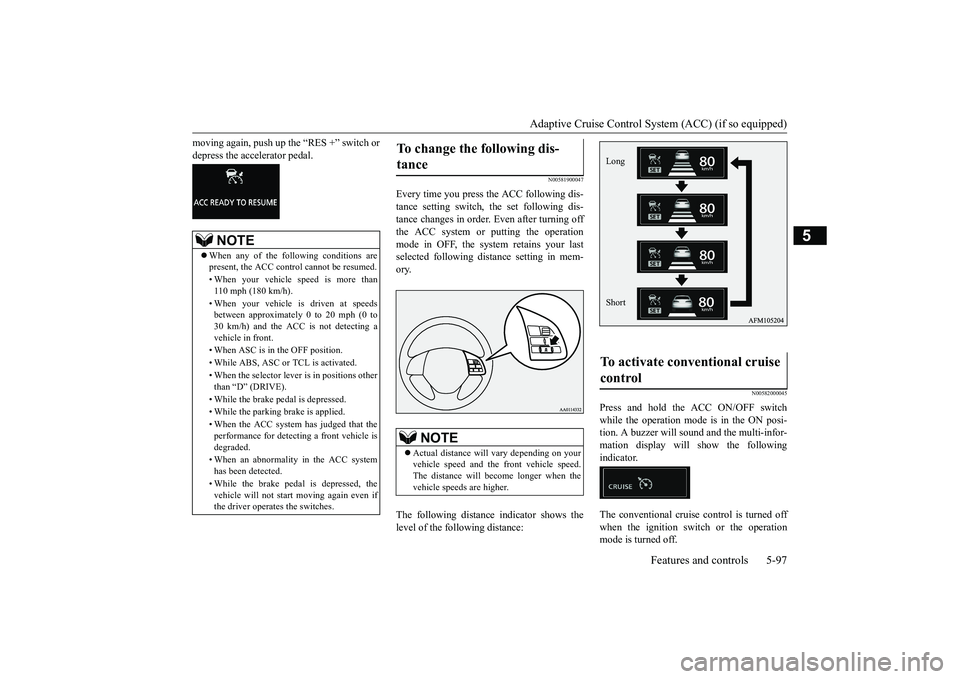
Adaptive Cruise Control System (ACC) (if so equipped)
Features and controls 5-97
5
moving again, push up the “RES +” switch or depress the accelerator pedal.
N00581900047
Every time you press the ACC following dis-tance setting switch, the set following dis- tance changes in order. Even after turning off the ACC system or putting the operationmode in OFF, the system retains your last selected following distance setting in mem- ory. The following distance indicator shows the level of the following distance:
N00582000045
Press and hold the ACC ON/OFF switch while the operation mode is in the ON posi-tion. A buzzer will sound and the multi-infor- mation display will show the following indicator. The conventional cruise control is turned off when the ignition switch or the operationmode is turned off.
NOTE
When any of the following conditions are present, the ACC control cannot be resumed. • When your vehicle speed is more than 110 mph (180 km/h). • When your vehicle is driven at speeds between approximately 0 to 20 mph (0 to 30 km/h) and the ACC is not detecting avehicle in front. • When ASC is in the OFF position.• While ABS, ASC or TCL is activated. • When the selector lever is in positions other than “D” (DRIVE). • While the brake pedal is depressed. • While the parking brake is applied.• When the ACC system has judged that the performance for detecting a front vehicle isdegraded. • When an abnormality in the ACC system has been detected. • While the brake pedal is depressed, the vehicle will not start moving again even if the driver operates the switches.
To change the following dis- tance
NOTE
Actual distance will vary depending on your vehicle speed and the front vehicle speed. The distance will become longer when thevehicle speeds are higher.
To activate conventional cruise control
Long Short
BK0266800US.bo
ok 97 ページ 2018年6月27日 水曜日 午後5時6分